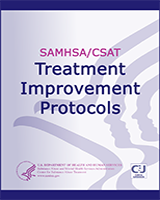NCBI Bookshelf. A service of the National Library of Medicine, National Institutes of Health.
Center for Substance Abuse Treatment. Clinical Guidelines for the Use of Buprenorphine in the Treatment of Opioid Addiction. Rockville (MD): Substance Abuse and Mental Health Services Administration (US); 2004. (Treatment Improvement Protocol (TIP) Series, No. 40.)
This publication is provided for historical reference only and the information may be out of date.

Clinical Guidelines for the Use of Buprenorphine in the Treatment of Opioid Addiction.
Show detailsThe privacy and confidentiality of individually identifiable drug or alcohol treatment information is protected by SAMHSA confidentiality regulation Title 42, Part 2 of the Code of Federal Regulations (42 C.F.R. Part 2). This regulation requires that physicians providing opioid addiction treatment obtain signed patient consent before disclosing individually identifiable addiction treatment information to any third party. On the next page is a sample consent form containing all the data elements required by 42 C.F.R. Part 2.
- I (name of patient) _______________
- Authorize: Dr. _______________
- To disclose: (kind and amount of information to be disclosed)Any information needed to confirm the validity of my prescription and for submission for payment for the prescription.
- To: (name or title of the individual or organization to which disclosure is to be made)The dispensing pharmacy to which I present my prescription or to which my prescription is called/sent/faxed, as well as to third party payors.
- For (purpose of the disclosure)Assuring the pharmacy of the validity of the prescription, so it can be legally dispensed, and for payment purposes.
- Date (on which this consent is signed)
- Signature of patient
- Signature of parent or guardian (where required)
- Signature of individual authorized to sign in lieu of the patient (where required)
- This consent is subject to revocation at any time except to the extent that the program which is to make the disclosure has already taken action in reliance on it. If not previously revoked, this consent will terminate on: (specific date, event, or condition)
Termination of treatment.
(c) Expired, deficient, or false consent. A disclosure may not be made on the basis of a consent which: (1) Has expired; (2) on its face substantially fails to conform to any of the requirements set forth in paragraph (a) of this section; (3) is known to have been revoked; or (4) is known, or through a reasonable effort could be known, by the individual holding the records to be materially false. (Approved by the Office of Management and Budget under control number 0930‐0099.)
Notice to accompany disclosure:
Each disclosure made with the patient’s written consent must be accompanied by the following written statement: This information has been disclosed to you from records protected by Federal confidentiality rules (Title 42, Part 2, Code of Federal Regulations [42 C.F.R. Part 2]). The Federal rules prohibit you from making any further disclosure of this information unless further disclosure is expressly permitted by the written consent of the individual to whom it pertains or as otherwise permitted by 42 C.F.R. Part 2. A general authorization for the release of medical or other information is NOT sufficient for this purpose.
- Appendix D Consent to Release of Information Under Title 42, Part 2, Code of Fed...Appendix D Consent to Release of Information Under Title 42, Part 2, Code of Federal Regulations - Clinical Guidelines for the Use of Buprenorphine in the Treatment of Opioid Addiction
Your browsing activity is empty.
Activity recording is turned off.
See more...